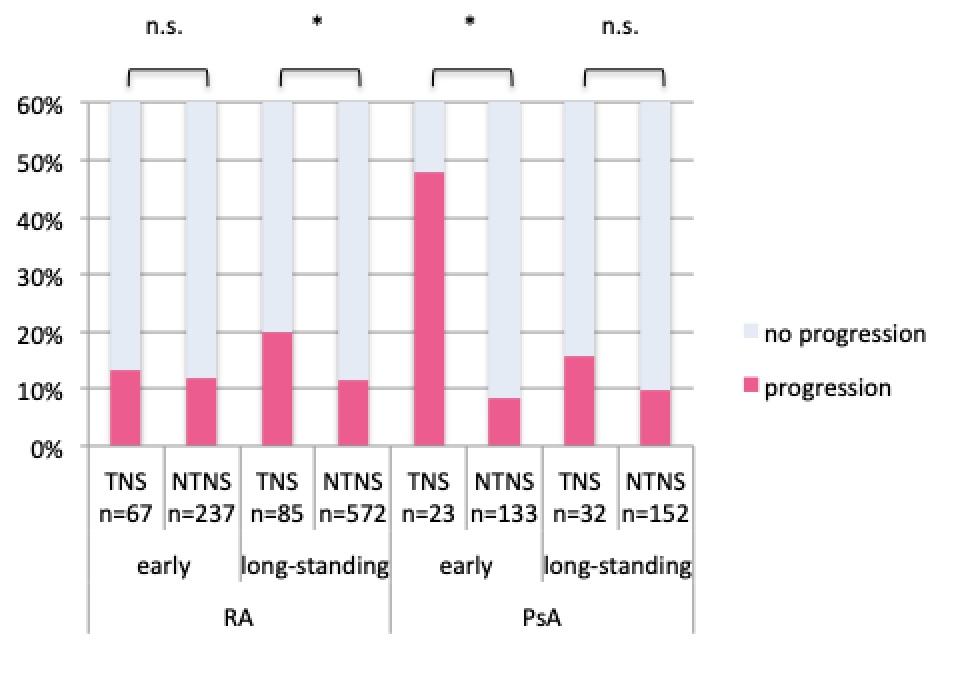Session Information
Session Type: Poster Session A
Session Time: 8:30AM-10:30AM
Background/Purpose: In rheumatoid arthritis (RA) and psoriatic arthritis (PsA), swelling is regarded as a sign of synovitis and is associated with radiographic progression. However, recent studies show that tenderness might only be a sign of inflammation in early, but not in long-standing disease. Furthermore, the association of tenderness with radiographic progression is not clear. The aim of this study was to assess the predictive value of tenderness in RA and in PsA generally as well as in early and long- standing disease.
Methods: Patients with RA and PsA with at least one tender joint were included. Sonographic (Power Doppler (PD) and gray-scale (GS)) and clinical examination (tenderness and swelling) of 22 joints of the hands as well as x-ray of the hands were performed. Radiographs were scored for erosions and joint space narrowing (JSN) and progression in each joint was assessed on a follow-up x-ray after 2 years. Patients were divided into early (≤3 years) and long-standing (≥5 years) disease groups. Logistic regression analyses (forward stepwise conditional approach) including tenderness, GS and PD (model 1) as well as additional factors erosion and JSN at baseline (model 2) in non-swollen joints were calculated for each group.
Results: We included 2.288 joints in RA and 484 joints in PsA. In early RA, only PD remained in model 1 (OR 3.58 95%CI 1.50-8.57, p< 0.01) and only JSN remained in model 2 (OR 1.83, 95%CI 1.26-2.65, p< 0.01). In long-standing RA only PD (OR 2.78, 95%CI 1.53-5.08, p< 0.01) and tenderness (OR 2.00, 95%CI 1.09-3.64, p=0.02) remained in model 1, while only JSN (OR 1.27, 95%CI 1.12-1.44, p< 0.01) and PD (OR 2.19, 95%CI 1.15-4.17, p=0.02) remained in model 2.
In early PsA, only tenderness (OR 6.60, 95%2.04-21.31, p=0< 0.01) remained significant in model 1, while in model 2, only erosions (OR 30.37, 95%CI 5.26-175.37, p< 0.01) remained significant. In model 1 in long-standing PsA, only PD (OR 10.36, 95%CI 3.25-33.03, p< 0.01) remained in the model. In model 2 in long-standing PsA only JSN (OR 2.59, 95%CI 1.59-4.22, p< 0.01) remained significant.
Conclusion: The results of this study show that tenderness in non-swollen joints is not a major risk factor for subsequent radiographic progression in RA and PsA. In all observed groups, tenderness did not remain in the model after adding JSN and erosions suggesting that tenderness might be rather an indicator of structural damage than of current inflammation. Over all groups, PD showed a higher association with radiographic progression than tenderness except for early PsA, where tenderness seems to be a risk factor for subsequent damage.
To cite this abstract in AMA style:
Gessl I, Popescu M, Supp G, Durechova M, Zauner M, Smolen J, Aletaha D, Mandl P. Tenderness and Radiographic Progression in Rheumatoid Arthritis and Psoriatic Arthritis [abstract]. Arthritis Rheumatol. 2021; 73 (suppl 9). https://acrabstracts.org/abstract/tenderness-and-radiographic-progression-in-rheumatoid-arthritis-and-psoriatic-arthritis/. Accessed .« Back to ACR Convergence 2021
ACR Meeting Abstracts - https://acrabstracts.org/abstract/tenderness-and-radiographic-progression-in-rheumatoid-arthritis-and-psoriatic-arthritis/

